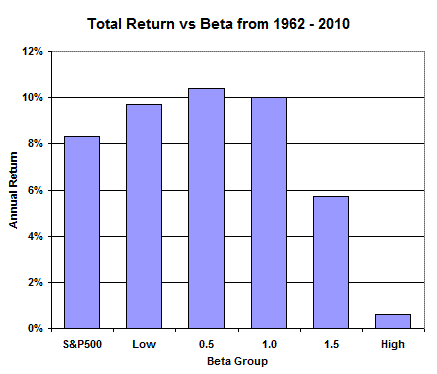|
|||||||||||||||||||||||||||||||||||||||||||||
|
|||||||||||||||||||||||||||||||||||||||||||||
|
The merry-go-round beats the roller coaster I have fond summer memories of rushing through the gates of my local amusement park and riding the roller coasters all day long. Up and down, round and round. It was grand fun. Alas, advancing decrepitude makes riding the metal monsters an exercise in nausea these days. They're almost as bad as the stock markets which are currently providing a wild enough ride of their own. If you're also turning a little green, I've some good news. You can hold placid lower-risk stocks and still achieve market-topping returns. The notion that low-risk stocks outperform runs in direct contradiction to much of 20th century academic thinking on the markets. After all, you've probably heard that you have to take on more risk to earn higher returns. Problem is, it's only partially true. Better expressed, you should avoid extremes and opt for moderation. At the low risk end you effectively pay a high price for guarantees. For instance, short-term government bonds provide parsimonious yields in exchange for some certainty. At the other end of the risk spectrum lottery tickets tend to be rather poor bets except in a few very rare circumstances. When it comes to stocks, high risk often yields poor returns. For proof, let's take a little diversion into risk measurement. I'll use beta as my risk measure due to its popularity. Beta puts a number on the tendency of stocks to move in sync with the markets. It is related to a combination of how volatile a stock is and how closely it is correlated with the market as a whole. Both factors are important. Roughly speaking, stocks with a beta of 1 tend to move in sync with the market. Those with a beta of 0 tend to move independently of the market, while stocks with high betas tend to fluctuate more than average. Low beta stocks are deemed to be safer while high beta stocks are thought to be riskier. If theory holds true, high-beta stocks should carry a risk premium and you should be rewarded for taking the risk of holding them. Problem is, investors haven't been paid this premium according to Eric Falkenstein which he explains in Finding Alpha: The Search for Alpha When Risk and Return Break Down. In the book he explores risk and reward in many fields from private equity, currencies, and corporate bonds to more unusual areas such as movie development and sports betting. He shows that taking really big risks is a poor bet across a wide spectrum of human endeavour. You might hear about the few winners, but the numerous losers rarely make a peep. Let's look at his data on stocks. Falkenstein tracks five stock portfolios based on beta from 1962 to 2010 and compares the returns to those of the S&P500. The first stock portfolio is formed by picking 100 stocks with the highest betas and the second contains 100 stocks with the lowest betas. The remaining portfolios focus on the 100 stocks with betas closest to 0.5, 1.0, and 1.5 respectively. The portfolio were rebalanced every six months and the long-term results shown in the accompanying graph. 
A few things should jump out at you. First, high beta stocks were very bad bets over the long-term. While the S&P500 posted average annual returns of 8.3% over the whole period, the high beta group only gained 0.6% a year. They underperformed by a whopping 7.7 percentage points annually. Second, you'd have beaten the market by about 2 percentage points annually by simply opting for moderate-to-low beta stocks. What's going on here? Why aren't investors compensated for holding risky stocks? I tend to favour a behavioural explanation. Simply put, people love playing the lotto even though it is a losers game. When they enter the stock market they tend to opt for riskier stocks, push prices far too high, and thereby reduce future returns. While I'm not convinced this is a complete explanation, it goes a long way. Practically speaking, the lesson is to stick to lower risk stocks. As it happens, some new exchange traded funds (ETFs) aim to do the heavy lifting for you. Russell recently launched a pack of 'factor' ETFs that track both high and low beta stocks. They come in two flavours. One set tracks stocks in the large-cap Russell 1000 index and the other follows small stocks in the Russell 2000. In addition, if beta isn't your thing, you can also buy volatility-based ETFs instead. Details for each ETF are shown in the accompanying table. Just be warned, these ETFs are new offerings, tend to trade infrequently, and may have wide bid-ask spreads. So, be sure to do your due diligence and be careful when trading. They aren't for everyone. Even if the new fangled ETFs aren't for you, it's a good idea to stick to dull and boring stocks which, rather remarkably, seem to have the tendency to outperform over the long haul. Even better, the ride isn't nearly so gut wrenching.
First published in the Globe and Mail, August 2011. |
|||||||||||||||||||||||||||||||||||||||||||||
| |||||||||||||||||||||||||||||||||||||||||||||
| Disclaimers: Consult with a qualified investment adviser before trading. Past performance is a poor indicator of future performance. The information on this site, and in its related newsletters, is not intended to be, nor does it constitute, financial advice or recommendations. The information on this site is in no way guaranteed for completeness, accuracy or in any other way. More... | |||||||||||||||||||||||||||||||||||||||||||||